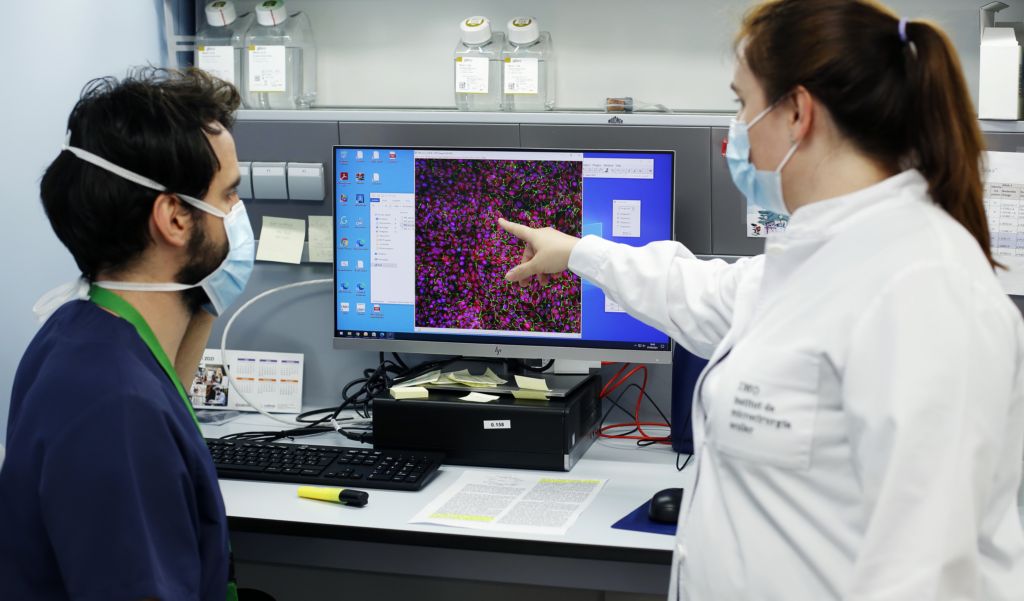
Modelos celulares pioneros para el futuro tratamiento de la retinosis pigmentaria
Promovido por Fundación IMO, el proyecto incluye trabajos punteros con organoides (cultivos celulares en 3D), primer paso para generar retinas “in vitro”
Nuestro equipo investigador ha diseñado, desde el laboratorio de biología molecular situado en la sede barcelonesa de IMO Grupo Miranza, varios modelos celulares pioneros para estudiar in vitro las mutaciones en siete genes asociados a distrofias de la retina, entre ellos, tres causantes de retinosis pigmentaria, que puedan ayudar a su tratamiento.
En el marco de este proyecto del Área de I+D+i de Miranza, promovido a través de Fundación IMO, se ha logrado obtener los dos tipos de células retinianas que se ven afectadas por estas enfermedades hereditarias: las células del epitelio pigmentario y las células fotorreceptoras.
Además, los investigadores de Miranza han ido un paso más allá y, a la vanguardia de los procedimientos más punteros internacionalmente, han empezado los trabajos con organoides (cultivos celulares en 3D) de retina. En una primera fase, se trata de agregados de células inmaduros y, próximamente, van a iniciar los protocolos para lograr organoides maduros, cuya estructura y funcionamiento se asemeje al de una retina real para poder estudiar las células afectadas por las distrofias retinianas en su contexto. Esto aportará información de gran valor para desarrollar tratamientos para la retinosis pigmentaria, entre otras distrofias, en los siguientes años.
Avanzar hacia el tratamiento de la retinosis pigmentaria
“Sabemos que la retinosis pigmentaria y otras distrofias de la retina dañan las capas más externas de este tejido ocular (el epitelio pigmentario y/o los fotorreceptores), pero aún desconocemos algunos de los mecanismos que lo hacen. Crear estos modelos celulares nos permite estudiar cuál es el efecto concreto de cada mutación, que puede actuar inhibiendo la expresión del gen o alterando su función de diferentes maneras”, explica la Dra. Esther Pomares, coordinadora de los proyectos de investigación básica de nuestro grupo.
La genetista añade que “a partir de una mayor comprensión de la enfermedad, podemos avanzar en una doble línea hacia futuros tratamientos para la retinosis pigmentaria y distintas distrofias de retina, patologías aún incurables. Por un lado, terapias génicas que aporten un nuevo gen o que desactiven el gen defectuoso y, por otro, terapias celulares, mediante la implantación de células sanas en la retina dañada”.
Impacto internacional de los hitos en nuestro laboratorio
Este es el propósito final de un proyecto que, iniciado en 2017, trabaja en la obtención de modelos celulares para el estudio de las distrofias de la retina. Las células del epitelio pigmentario y las células fotorreceptoras que se han logrado en nuestro laboratorio de IMO Grupo Miranza, así como los organoides, proceden de la diferenciación de células madre iPSC (células adultas “reprogramadas” para pasar a un estado similar a células madre embrionarias).
Estos modelos de células madre iPSC fueron obtenidos, a su vez, a partir de células de la piel de pacientes con distrofias retinianas, un hito publicado en 2020 en revistas científicas internacionales y en el que se interesó el National Eye Institute NIH de Estados Unidos.
A través de un acuerdo de colaboración entre esta institución y Fundación IMO, cedimos algunos de los modelos, compartiendo el hallazgo con la comunidad científica para progresar en el tratamiento de estas enfermedades oculares minoritarias, como la retinosis pigmentaria, de origen genético y responsables de pérdida severa de visión. Con ello, seguimos avanzando para que el futuro tratamiento de la retinosis pigmentaria y otras distrofias de la retina esté más cerca.